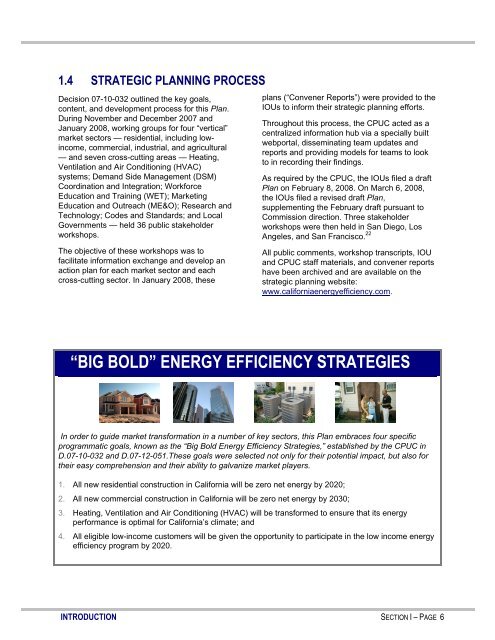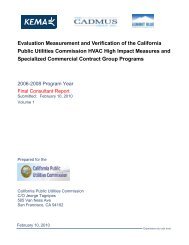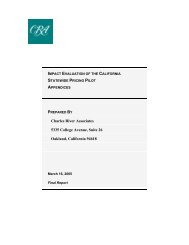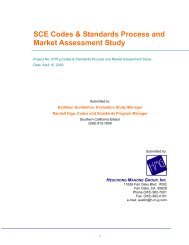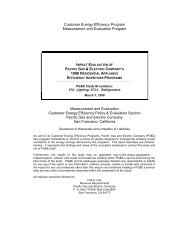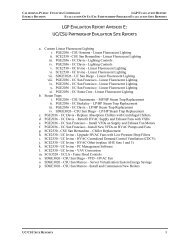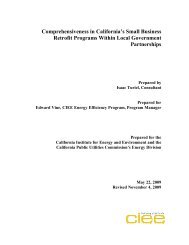Long Term Energy Efficiency Strategic Plan - California Public ...
Long Term Energy Efficiency Strategic Plan - California Public ...
Long Term Energy Efficiency Strategic Plan - California Public ...
You also want an ePaper? Increase the reach of your titles
YUMPU automatically turns print PDFs into web optimized ePapers that Google loves.
1.4 STRATEGIC PLANNING PROCESS<br />
Decision 07-10-032 outlined the key goals,<br />
content, and development process for this <strong>Plan</strong>.<br />
During November and December 2007 and<br />
January 2008, working groups for four “vertical”<br />
market sectors — residential, including lowincome,<br />
commercial, industrial, and agricultural<br />
— and seven cross-cutting areas — Heating,<br />
Ventilation and Air Conditioning (HVAC)<br />
systems; Demand Side Management (DSM)<br />
Coordination and Integration; Workforce<br />
Education and Training (WET); Marketing<br />
Education and Outreach (ME&O); Research and<br />
Technology; Codes and Standards; and Local<br />
Governments — held 36 public stakeholder<br />
workshops.<br />
The objective of these workshops was to<br />
facilitate information exchange and develop an<br />
action plan for each market sector and each<br />
cross-cutting sector. In January 2008, these<br />
plans (“Convener Reports”) were provided to the<br />
IOUs to inform their strategic planning efforts.<br />
Throughout this process, the CPUC acted as a<br />
centralized information hub via a specially built<br />
webportal, disseminating team updates and<br />
reports and providing models for teams to look<br />
to in recording their findings.<br />
As required by the CPUC, the IOUs filed a draft<br />
<strong>Plan</strong> on February 8, 2008. On March 6, 2008,<br />
the IOUs filed a revised draft <strong>Plan</strong>,<br />
supplementing the February draft pursuant to<br />
Commission direction. Three stakeholder<br />
workshops were then held in San Diego, Los<br />
Angeles, and San Francisco. 22<br />
All public comments, workshop transcripts, IOU<br />
and CPUC staff materials, and convener reports<br />
have been archived and are available on the<br />
strategic planning website:<br />
www.californiaenergyefficiency.com.<br />
“BIG BOLD” ENERGY EFFICIENCY STRATEGIES<br />
In order to guide market transformation in a number of key sectors, this <strong>Plan</strong> embraces four specific<br />
programmatic goals, known as the “Big Bold <strong>Energy</strong> <strong>Efficiency</strong> Strategies,” established by the CPUC in<br />
D.07-10-032 and D.07-12-051.These goals were selected not only for their potential impact, but also for<br />
their easy comprehension and their ability to galvanize market players.<br />
1. All new residential construction in <strong>California</strong> will be zero net energy by 2020;<br />
2. All new commercial construction in <strong>California</strong> will be zero net energy by 2030;<br />
3. Heating, Ventilation and Air Conditioning (HVAC) will be transformed to ensure that its energy<br />
performance is optimal for <strong>California</strong>’s climate; and<br />
4. All eligible low-income customers will be given the opportunity to participate in the low income energy<br />
efficiency program by 2020.<br />
INTRODUCTION SECTION I – PAGE 6


